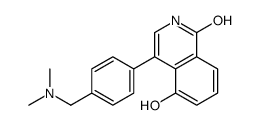651029-09-3
| Name | 4-[4-[(dimethylamino)methyl]phenyl]-5-hydroxy-2H-isoquinolin-1-one |
|---|---|
| Synonyms |
KCL 440
1(2H)-Isoquinolinone,4-[4-[(dimethylamino)methyl]phenyl]-5-hydroxy KCL-440 |
| Description | KCL-440 is a CNS-penetrated PARP inhibitor, with an IC50 of 68 nM. KCL-440 has strong inhibition of PARP-1[1][2]. |
|---|---|
| Related Catalog | |
| Target |
IC50: 68 nM (PARP)[1]. |
| In Vivo | The brain concentration of KCL-440 is sufficient to inhibit the PARP activity during the intravenous infusion at the rate of 1 mg/kg/h[1]. KCL-440 (over 0.03 mg/kg/h) exhibits neuroprotective effects of KCL-440 in the in vivo cerebral ischemia model[1]. Animal Model: Rat acute cerebral infarction model induced by photothrombotic MCA occlusion[1]. Dosage: 0.01, 0.03, 0.1, 0.3, 1.0, and 3.0 mg/kg/h. Administration: Intravenously administered at a rate of 0.33 ml/kg/h for 24 h immediately aftercerebral ischemia. Result: The serum concentration of KCL-440 approached steadystate levels within 1 h in rats that were intravenously infused at the rate of 1 mg/kg/h for 6 h. One hour after the initiation of infusion, the serum concentration of KCL-440 is 0.11 μg/mL, which is equivalent to 0.37 μM. The brain:serum concentration ratio after a 6-h infusion at 10 mg/kg/h is 0.8. Led to a dose-dependent reduction in the cerebral infarct size at 24 h after the MCA occlusion. |
| References |
| Molecular Formula | C18H18N2O2 |
|---|---|
| Molecular Weight | 294.35 |
| Exact Mass | 294.13700 |
| PSA | 56.59000 |
| LogP | 3.37460 |
